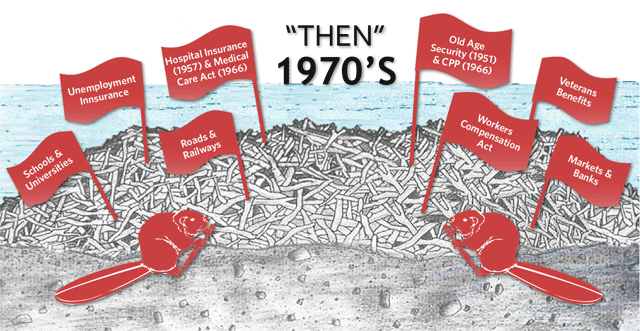Canadian Senator, Nicole Eaton, recently recommended that Canada replace the beaver as our national animal. She lamented that the beaver is a dentally deficient rodent, or toothy tyrant. But such critiques are all wet. Our national animal may not be as regal as the eagle to the south, but the beaver is a builder to be proud of.
Recall the last creek or river you passed by where beavers dutifully constructed a dam. Ever wonder why they build it?
Nobody lives in the dam. The dam does not provide shelter to a single beaver family.
Beavers build the dam, because the dam creates a reservoir. When the reservoir is deep enough, the beavers are efficient, able to swim faster than they can walk on land. When the reservoir is deep enough, the beavers gain security, further out of reach from bears and other predators. When the reservoir is deep enough, it provides a safe home for beavers to build lodges for their families.
Whenever the dam springs a leak, whether from wear, heavy runoff or an earthquake, busy beavers adapt, just as all good managers do. They fix the dam, renovating it to withstand the new challenges in their environment. No individual beaver stands to gain alone. Beavers adapt because they all depend on the dam to safeguard their shared standard of living.
Such logic guides this blog. Throughout my posts, I will urge readers to think like a beaver: to renew interest in our national dam – the policy on which citizens depend to safeguard our shared standard of living – and to ask some fundamental questions. Who stands on guard for the dam? When did we last renovate it? What are the greatest challenges to which we must adapt? How should we respond?
Thinking like a Beaver is important now, because in this era of economic uncertainty and global insecurity, so much attention is given to what constrains Canada, to what Canadians can’t do, or can’t afford. This focus risks diminishing our national aspiration, and neglects our proud history of building and adapting.
Think back to the late nineteenth century, when we built public schools and universities, roads and railways, markets and banks. We were so proud of these achievements, we sent soldiers overseas to defend them along with our values. When they returned home injured, we adapted again, building veterans benefits. We soon extended these to citizens generally as workers compensation and unemployment insurance. And then the busiest policy beavers in Canada’s history – the parents of the Baby Boomers – set in motion Old Age Security and Hospital Insurance. By 1966, in one single year, they capped their accomplishments by launching the Canada Public Pension plan and the Medical Care Act, which remain the cornerstones of our social commitments to one another as citizens.
This history is impressive, one we can all be proud of. But we can only rest on our laurels for so long. We must now ask: What have we built since?
Sure we’ve continued to build roads and bridges (but not enough transit!). We’ve expanded markets and strengthened our banks – achievements that helped us weather the global recession better than most countries, and position us as a strong member of the G-8 despite our small population.
On the other hand, history books make clear Canadians have been reticent to build new social policy since the 1970s. This reticence is especially evident in our slow national response to a disturbing reality – that the generation raising young kids today is the first in a long time to struggle with a dramatically lower standard of living than their parents. For the most part, this struggle remains an untold story in Canada.
It is now time to tell it.


